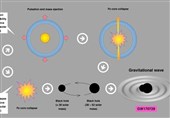Fastest Ever Star Discovered Orbiting Milky Way's Supermassive Black Hole
TEHRAN (Tasnim) – Astronomers have just discovered the quickest star at the center of the Milky Way that is orbiting around Sagittarius A black hole at 8% the speed of light.
At the center of our galaxy is Sagittarius A* (Sgr A*), a humongous black hole about four million times the mass of our sun. Being so big, its gravitational effects are extreme and they can be detected by looking at the stars in its immediate vicinity, Cnet reporetd.
Orbiting Sgr A* are a handful of stars (and some mysterious objects), locked in a cosmic two-step with the invisible monster, moving at mind-melting speeds.
And astronomers have just discovered the quickest of the lot, clocking its fastest speed around Sgr A* at 8% the speed of light.
A study, published in The Astrophysics Journal on Tuesday, examined the area surrounding Sgr A*, looking for the signature signs of stars. Previous research has discovered dozens of stars moving around the supermassive black hole on highly unusual orbits. This population of stars are known collectively as the S-stars and some of them orbit incredibly close to the black hole, making them difficult to detect.
But the research team, using instruments installed at the European Southern Observatory's Very Large Telescope in Chile, scoured through images taken between 2004 and 2016, adding five new stars, S4711-S4715, to the population and tracking their movements around Sgr A*. Their results show more evidence that a distinct population of stars orbit Sgr A* at distances comparable to the size of our solar system.
And being so close to the terrifying, bottomless abyss at the center of the Milky Way, they are privy to some extreme physics.
Florian Peissker, an astronomer at the University of Cologne in Germany, and his team have been studying the region of space close to the black hole intensely. In January, they reported observations of the star S62. Their observations, published in the Astrophysics Journal, revealed S62 was orbiting the black hole once every 9.9 years, giving it the shortest orbital period and making it the fastest star to blitz around the Milky Way's black hole.
But Peissker and colleagues new data has seen S62 drop both of its records.
According to The Astronomer's Telegram, one of the newly-discovered stars, S4711, orbits the Milky Way's black hole once every 7.6 years, claiming the record for the shortest orbital period.
Another star, S4714, is even more extreme. It doesn't quite get as close to Sgr A* as S4711 but it's travelling around the black hole at 8% the speed of light. At that speed, the star is moving about 15,000 miles (24,000 kilometers) every second, which would mean it could make one full lap of the Earth in just over 1.5 seconds.
The highly-eccentric orbits of the S-stars aren't just cosmic curiosities either; the stars help to establish further evidence for Einstein's general theory of relativity. The theory predicts how space, time and gravity interact and suggests huge, dense objects like black holes can warp space around them. Studying the S-stars, astronomers can see some of the motion predicted by Einstein's theory. A team from the Max Planck Institute recently did so, when they studied the star S2 earlier this year and found it adhered strictly to Einstein's theory.
The team believe improved data analysis could yield even further insight into the space around Sgr A* and they expect more stars on extremely tight orbits to be discovered in "the near future." The Extremely Large Telescope, which is expected to become operational in 2025, will gather 13 times more light than any optical telescope operational today and should help locate a few more. Until then, S4714 gets to wear the crown.






